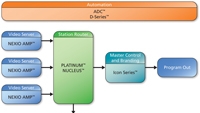IBC2009 has strong showing from automation vendors

At IBC2009, there seemed to be more activity at the stands of broadcast automation vendors than at this year’s NAB. Because automation systems are generally installed as part of a project rather than an ad hoc purchase such as a VTR deck or CG, the current economic woes must have impacted orders. I got several different messages from vendors. Some are seeing continuing business, while others are seeing projects delayed. Possibly in an effort to generate interest, some companies introduced rebranding. Harris is branding its master control system as Launchpad, and On-Air Systems has gone for a company complete rebrand and is now OASYS. But one message was the same throughout the show: Sales forecasting is difficult because business investment has become unpredictable.
The automation market is continuing to split between the all-in-one systems and the “separates” — servers, switchers and CGs. Matrox video processors proved popular in many of the channel-in-a-box solutions, and a handful of vendors were offering systems running on the Mac platform. There was certainly choice in architecture and implementation. There was a product to suit every pocket, and for transmission service providers, different SLAs.
Several vendors spoke of the demand for increased integration with data-driven graphics systems for more sophisticated channel branding. Much of this drive is to cut the cost of producing graphics sequences in post. This technology has much in common with the MOS-driven graphics systems that have become an essential part of the modern newsroom.
Now that equipment to run back-to-back clips in a playlist has become a commodity, the current round of automation products are offering increased interaction with back-office systems (often through BXF), more automated graphics creation including 3D, lower cost and simpler integration.
The European broadcasters often have complex demands. These may be to manage regulations around the proportion of spots to programs or it may be to handle regional splits at different times of the day. However, there is still an increasing demand for straight playout at a low cost for IPTV, satellite and cable channels. It is this diversity that not only supports the existing vendors, but provides opportunities for those who believe they have a “better mousetrap.”
The professional video industry's #1 source for news, trends and product and tech information. Sign up below.
